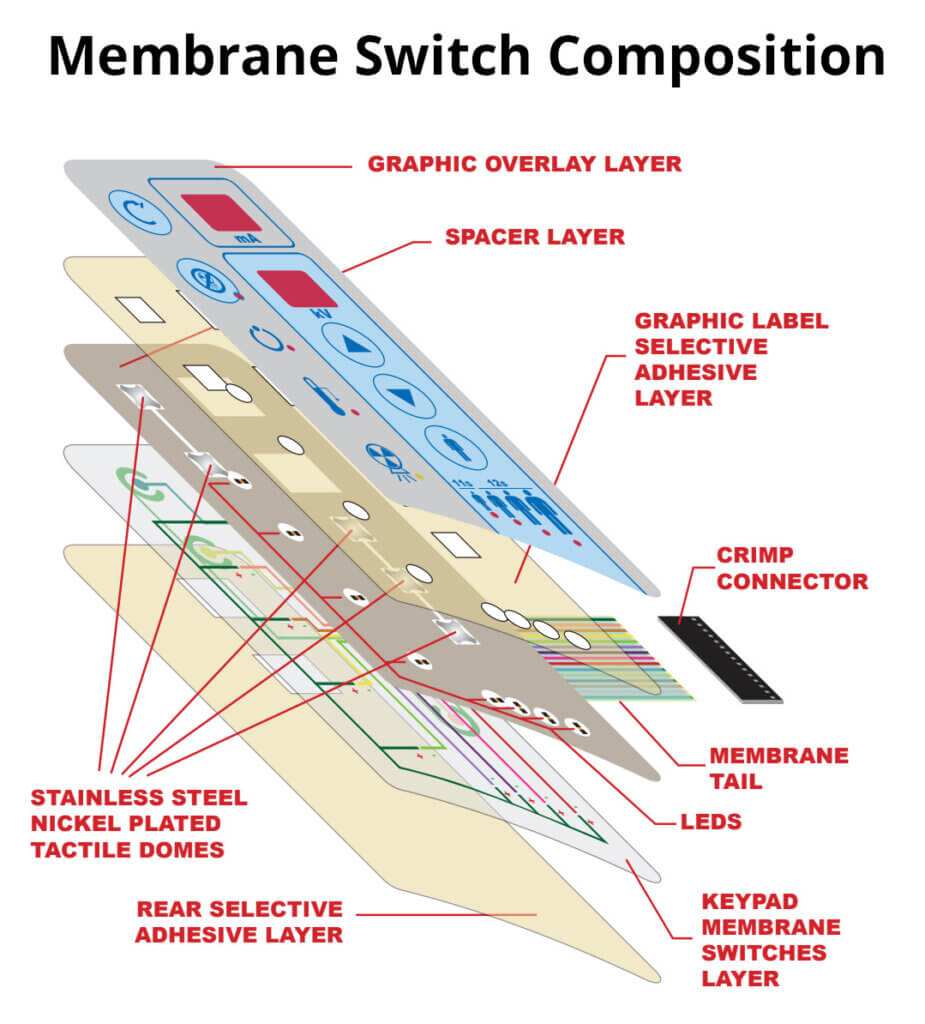The Role of Membrane Switches in Enhancing Device Functionality
The Role of Membrane Switches in Enhancing Device Functionality
Blog Article
Understanding Membrane Switches: The Key to Long Lasting and Reputable Controls

What Are Membrane Layer Switches?
Membrane switches are a sophisticated service in the realm of interface innovation, combining capability and style flawlessly. These devices act as an interface between individuals and electronic systems, incorporating numerous parts right into a portable style. Typically created from flexible, thin layers of materials, membrane layer switches are created to react to touch, making it possible for customers to interact with machinery and electronic devices efficiently.
The key components of a membrane layer switch consist of a printed circuit layer, graphic overlay, and a spacer layer that avoids unintentional activation. The visuals overlay can be personalized to show brand identification or customer choices, enhancing aesthetics while ensuring functionality. Membrane layer buttons are commonly used in various applications, consisting of clinical devices, consumer electronics, and commercial tools, owing to their resilience and resistance to ecological aspects such as wetness and dust.
Among the key advantages of membrane layer buttons is their capacity to endure wear and tear, making them suitable for high-traffic settings. In addition, they are lightweight and need marginal room, allowing for ingenious styles in item advancement. In general, membrane layer switches represent a effective and functional choice for modern-day electronic user interfaces, weding modern technology with user-centric style concepts.
How Membrane Switches Work
The procedure of membrane switches over joints on a basic yet effective mechanism that converts individual input into electronic signals. When a user presses the switch, the leading layer warps, permitting a conductive element in the circuit layer to make contact with a matching conductive pad on the bottom of the graphic overlay.
The style of membrane buttons can vary, but they often integrate domes or responsive elements to supply comments to the individual, enhancing the overall experience - membrane switch. The products made use of in membrane switches, such as polyester or polycarbonate, add to their resilience and resistance to environmental variables, including wetness and dirt. The published circuits are generally enveloped, which secures them from wear and tear over time.
Benefits of Membrane Buttons

In addition, membrane layer buttons are recognized for their resilience. Constructed from durable materials, they are immune to dirt, wetness, and physical wear, which considerably prolongs their lifespan compared to standard mechanical buttons. This durability makes them especially ideal for high-traffic environments and applications calling for durability.
Another significant benefit is the simplicity of cleaning and upkeep. The smooth surface area of membrane layer changes lessens dust accumulation and is usually unsusceptible spills, making them ideal for setups that need constant sanitization.
In addition, membrane buttons provide a structured profile, bring about a thinner design that can be integrated right into numerous devices without including bulk. This function not just enhances the visual allure however likewise contributes to a more ergonomic product layout.
Applications of Membrane Layer Buttons
Flexible and straightforward, membrane switches locate applications across a vast array of sectors, consisting of medical tools, consumer electronic devices, and commercial devices. In the clinical area, these buttons are integral to gadgets such as analysis tools, person tracking systems, and infusion pumps, where dependability and ease of cleansing are important. Their capacity to hold up against severe settings and maintain performance makes them perfect for such applications.

In consumer electronics, membrane switches are used in products like microwaves, washing devices, and remote controls - membrane switch. Their sleek layout enables intuitive user interfaces, enhancing the overall user experience while offering sturdiness and resistance to deterioration
Commercial devices additionally takes advantage of membrane switches, particularly in control panels for machinery and automation systems. These switches provide protection versus dust and dampness, making certain constant efficiency in tough settings. In addition, their adjustable attributes enable makers to tailor them to particular operational demands, improving efficiency and functionality.
Choosing the Right Membrane Layer Change
When choosing a membrane layer button, it is necessary to take into consideration different factors that affect efficiency and viability for particular applications. The main factors to consider consist of ecological conditions, tactile responses, durability, and style specifications.
First, assess the operating atmosphere; buttons subjected to dampness, chemicals, or severe temperatures need specific materials to make sure longevity and performance. Next, examine the demand for tactile comments. Depending upon individual interaction, some applications might take advantage of a tactile action to verify activation, while others might like a non-tactile style for visual factors.
Longevity is an additional vital variable; membrane layer buttons ought to be created to withstand constant use, impacts, and abrasion. Guarantee the picked button can sustain the expected lifecycle, especially in high-usage circumstances.

Verdict
In final thought, membrane layer switches serve as essential elements in the style of long lasting and trustworthy control systems throughout numerous industries. The versatility of membrane changes enables for tailored solutions that meet certain operational demands, reinforcing their value in modern technology.
Membrane changes represent an essential facet of modern user interface layout, blending performance with durability in numerous applications.Membrane buttons are an advanced service in the realm of user interface modern technology, integrating functionality and layout seamlessly. Usually created from versatile, slim layers of materials, visite site membrane layer switches are created to react to touch, making it possible for individuals to interact with equipment and digital tools successfully.
The layout of membrane switches can differ, yet they usually incorporate domes or responsive aspects to supply responses to the customer, enhancing the overall experience.In final thought, membrane layer switches offer as crucial components in the layout of look at this web-site dependable and long lasting control systems throughout different sectors.
Report this page